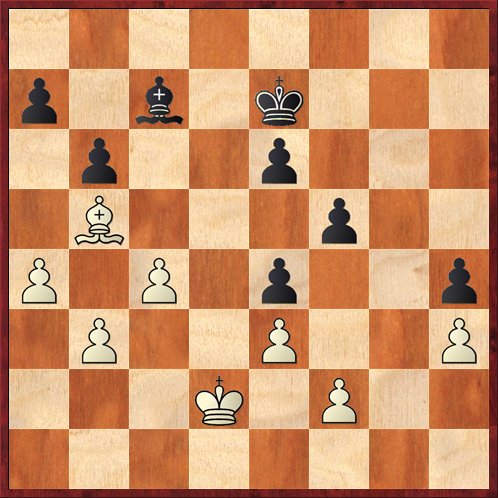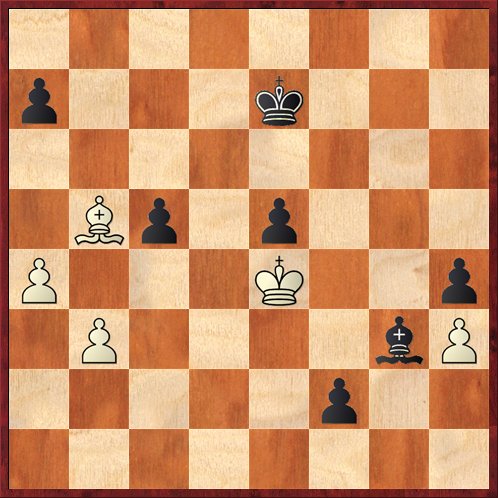Last week I said I was going to show you two interesting endgames. I want to keep my promise, but the second endgame I’m going to show you is not the one I originally intended! The change in plans is because I’m going to lecture on that one for ChessLecture, and I don’t want to upstage my own lecture. Sometime after the lecture goes up I will write about it here.
Instead I’ll show you a cool endgame that Mike Splane showed at his n-th chess salon yesterday, which shows that bishops of opposite colors are not as drawish as everybody thinks. Strictly speaking, the position should be a draw, almost to the very end, but Mike shows the value of never giving up as long as there are tricks that can be played.
Mike was Black, and a class-A player from the Kolty club (whose name I should remember, but don’t) was White.
First, I have to apologize that the above PGN may not be exactly right, because I did not write the moves down. In the initial position the bishop may have been at e5 rather than c7, and definitely some of the moves after move 4 in the above line were not how the game went. However, I’m showing you roughly how it went. Mike, if you want to jump in and make corrections please feel free to do so.
So here is the starting position, with some uncertainty about the placement of Black’s bishop.
Black to move.
First of all, I should tell you that many moves ago, when there were rooks still on the board, Mike played … h4 aiming for this position. His idea was to trade off all the rooks and set up the following trap.
White has just played 1. Kd2. This is a fine move but he could have played 1. Ke2. The move he played gave Mike hope that he might be oblivious to the shakiness of his kingside. Therefore, Mike innocently played the move 1. … Bd6!
The exclamation point is purely for psychology. He wants his opponent to think that there is something going on with … Bb4+, and thus lure him into the following mistake:
2. Kc3?? …
This doesn’t quite lose, but it puts White’s game in needless jeopardy. Now Mike uncorked the move that he already saw 10 moves ago:
2. … Bg3!
The bishop cannot be taken because Black would queen on g1. Also White cannot defend the f2Â pawn. Note that with the king on d2 this sacrifice would not have worked.
Still, all is not lost yet for White. A few moves later we got to a position something like this.
Again I apologize for the fact that I don’t know exactly how we got here. In the PGN I’ve put one possible sequence of moves, although I know it’s not exactly how the game went.
When I saw this position I still couldn’t imagine how White could ever lose. If he just keeps the king on e4, Black can never penetrate on the kingside. But I was a little bit too naive. Black can penetrate on the queenside, with Kd6-c7-b6-a5-b4-c3 etc. So White is going to have to give way at some point and retreat his king to e2. However, I don’t think he had to retreat as far as he did in the game.
Where do you think that the Black king is going on his long march via the hinterlands of a5 and b4? Answer: He’s going to g3! This is another master-level trick: move to the queenside when actually you want to get to the kingside. At the salon, we compared it to a play fake in (American) football, or a reverse (where the team starts moving one way and then the ball is handed off to a runner going the other way).
However, I should add that it’s really not a trick. Because Black’s path to g3 is blocked on the kingside, it’s really the only way that he can get there.
Many moves later, we got to this position, or something quite similar.
White to move.
White can still draw this game, but there is now only one correct move. (By the way, the computer is incredibly bad at this type of position. When I put it on Rybka 3 and let it run for several minutes, it couldn’t see any difference between any of White’s moves. They all led to a 2.11-pawn advantage for Black. That’s nonsense, of course. One move leads to a draw and the others lead to a loss.)
The right move is not hard to see. White must keep Black’s king from getting to g3. At the same time, he can’t do so by playing 1. Kg2 right away, because that would allow Black a decisive penetration with 1. … Ke2. So White has to play 1. Bg4. In order to get his king to g3, Black will now have to go via f4 (after first moving his bishop to d4 to protect the f2 pawn). As soon as Black plays … Kf4, White must move Kg2. Black will have no way of breaking through.
Instead, in this position or one like it, White (who by this point was down to a minute or two) played some move like 1. Bc4, allowing 1. … Kf3, and then the game was over. Black’s plan is to put his king on g3, push his pawn to e3, place his bishop on d4, and then play e2. If White takes with the king, then … Kg2 wins. If White takes with the bishop, then … Kxh3 wins.
What a triumph for long-term strategic thinking! And a great example of being patient and letting your opponent hang himself.






{ 3 comments… read them below or add one }
Hi Dana,
A few corrections are needed to the diagrams.
In the first diagram, The pawn on a7 should be on b7. My bishop was on e5, where it prevented Kc3 and my king on e7 is stopping all of his bishop moves.
White had been winning this game for so long that I wondered if he would still be trying to win. The only way to do that is to break through with his queenside pawn majority so I let his king go to c3. He bit on the bait.
One correction on the list of moves, Black played 4… Bd1 insteaf of 4 …e5. I wanted to leave the e5 square free for my bishop but actually you are right, 4 … e5 is a better move. Indeed I eventually had to play Bd1-c3-e5-g3 to hold onto both the f and h pawns.
In the second digaram the Black pawn should be on d6 instead of 35, the Black king should be on d6, and the Black pawn should be on b7 instead of a7.The White bishop was on c4.
But the critical features of the position in the asecond diagram are correct. The winning idea is to use the f2 pawn as a decoy to pick up another pawn and get two separated passed pawns.
Note that my opponent, Felix Hernandez-Campos, found the correct way to defend the position after 1 … Bg3. By forcing the f-pawn to advance to a black square he is able to set up a bloackade on the the defensive line b5-c4- e2-f1. His bishop, queenside pawns and king can work as a team so he always has two ways to capture on those four squares and my king is not enough by itself to break the blockade.
In the third diagram the pawn on a7 should be on b6 and the pawn on e4 should be on e5. This position was with Black to move. The White bishop was on g4 and he has just moved it to e6, which was the losing move. He should have moved it to e2, d1, or h5 to prevent my king coming to f3.
Your summary of the key ideas in this position was exactly right, except for the last bit. When we reach the position with Black Kg3, Bd4 and White Kf1 Bg4 White is in zugzwang. Black does not play …e2. Instead he plays …Kh2 when the White king can not move – …Kg1 wins immediately. So the White bishop must move, allowing either the immediately winning e2+ or the capture of the h3 pawn. The lesser evil is to give up the h3 pawn so White mus play something like Be2. Tthe win after that is simple, …Kh3 … Kg3 … h3 … and …h2..
It was an interesting coincidence that the key moves in winning this endgame occurred on the same square, first … Bg3 and then … Kg3.
Hi Mike,
Thanks for the corrections. Yes, I remember now about the doubled b-pawns — I had forgotten about them. Of course it never really mattered whether the pawn was on b7 or a7.
In the final position, where you played … Kh7 instead of … e2+, is it not true that … e2+ also wins? The reason is just what I wrote — if White takes with the king, then … Kg2 happens, and if White takes with the bishop, then … Kxh3 happens. So you didn’t actually have to play for the zugzwang. Of course, the zugzwang was cute, too.
I wish I could have reconstructed the position where you played … h4. I don’t know what the proper annotation for that move would be. On the one hand, maybe ?? because it opened the g-file and it looked as if White could have won right then and there with Rg6. On the other hand, maybe !! because it was based on the deep positional idea of trading rooks and sacking the bishop on g3. I was thinking of annotating it as … h4??(!!).
“In the final position, where you played … Kh7 instead of … e2+, is it not true that … e2+ also wins?”
During the game I didn’t think so. After trading the White h-pawn for the Black e-pawn White puts his bishop on the h1-a8 diagonal and leaves his king on f1. I didn’t see how to queen either pawn.
But your conclusion is correct. Black wins by moving his king to c3, pushing the h-pawn to force White to take it with his bishop. and capturing on b3. After that the win is easy.
My idea to play … h4 is correct, but my move order was not, so I would award the move at least one question mark. It turned a darw uintio a clear loss. If I had first played … Kh8 or … Kf8, to avoid the check on g1, I would be a tempo ahead of the game continuation and would have had no problems.
BTW, I think this is at least the third time you’ve mentioned my “patience” in one of your blog posts. I learned this patient method of handling positions from Shereshevsky’s book, “Endgame Strategy.” Chapter 5 is called “Do Not Hurry.”